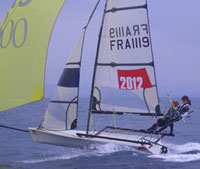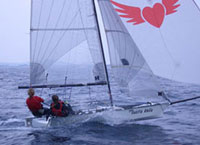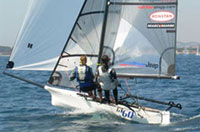
FBISAFSt
In this age of “extreme,” where the better boat is the one that’s faster and wetter, ISAF is considering adding a high-performance dinghy to the women’s Olympic sailing disciplines. At the Women’s High Performance Dinghy Evaluation Event in Hyeres, France, last month, ISAF took the first step towards choosing a women’s high performance dinghy for the 2012 Olympics.
ISAF’s fundamental criteria call for a monohull capable of sailing faster downwind than upwind, suitable for two women with a combined weight of 265-308 pounds, and priced around $19,650 ready to sail. In Hyeres, I joined a group of female test sailors and an ISAF committee to evaluate six different designs: International 14, RS800, Cherub Daemon, Carbonology GT60, 29erXX, and 29er.
With a few exceptions, the six boats are very similar-self-tacking jibs, twin trapezes, masthead kites, 3 shrouds, and tube-launching spinnakers.

International 14|
|** **|
**International 14
**Although the class has been around since the 1920s, the International 14 may be the most progressive design vying for a spot at the 2012 Olympics. The I14 has a T-foil rudder and a large, carbon rig supporting a powerful, square-top main that provides a lot of power in light conditions.
To modify the boat for lighter sailors, the I14 sailors in Hyeres proposed making it a one-design, with additional restrictions on the mast, sails and foils. I thought it was very fun to plane in 5 knots, but we were all curious to see how the boats would handle in more wind or with smaller crews.

RS800|
||
RS800
The RS800 was the only design at the trials to use a weight equalization rule, which requires teams to add lead if their combined weight is less than 140 kg. Rack placement also depends on a team’s righting moment-lighter teams can pull their racks farther outboard.
The RS800 is a strict one-design with an epoxy-foam-fiberglass sandwich hull, carbon composite mast and boom, and epoxy daggerboard and rudder. RS800 supporters claim that the rig is large enough to plane in 7 knots and responsive enough to stay in control in 25 knots. I found the RS800 to be incredibly easy to sail, thanks to its wide hull. Unfamiliar sailors can learn the RS800 quickly, which some testers found to be a drawback.

Cherub Daemon|
||
Cherub Daemon
A 75-kg one-design version of the box-rule Cherub class, the Cherub Daemon was among the lightest boats at the trials. (Cherub sailors boast that they can pick up their boats and carry them directly into the water.)
The Daemon sails with a twist-tiller controlled T-foil rudder, which really adds another dimension to the controls the sailors have at their fingertips. Many Cherub sailors adjust their T-foils with each puff and lull. I learned quickly that the T-foil causes a lot of drag at lower speeds when there is not much flow over the blade and wings, and that the tiller needs to be pushed over very far in order to get the boat to turn through a tack. Once there was a bit more wind, the boat was very fun to sail.

Carbonology GT60|
||
Carbonology GT60
The Carbonology GT60 was the newest design at the trials. In fact, the first day of the trials was the prototype’s second day in the water. Designed by International 14 designer Paul Bieker, the GT60 is basically an 85% scale version of the Beiker 5 I14.
An epoxy-carbon-foam hull and carbon spars account for the boat’s reduced weight (60 kg), and a purchase-controlled T-foil rudder and square-top make it one of the “techier” boats as well. The GT60 carries the same sail area as the heavier designs, which makes it faster-no a surprise coming from Paul Beiker. I thought that the GT60’s size felt appropriate for a women’s team. The boat is light and fun, and the T-foil seemed to work relatively well in light winds.
29erXX
The 29erXX was actually Julian Bethwaite’s original design for the 29er. Basically, the XX puts a 49er rig (double spreader, masthead kite) on a 29er hull. Without an adjustable rudder or other extra controls, the 29erXX is a simple design sensitive to sailors’ movements. 29erXX sailors must be incredibly athletic and coordinated.
The 29erXX and 29er were the only two designs at the trials with a solid hull with wings instead of racks. Although initially many thought that the hull would be too small for its rig, extensive training on San Francisco Bay has disproved that notion. In the light winds in Hyeres, some sailors found that the 29erXX felt underpowered. Others liked its responsiveness and felt it would provide a continuous challenge to advanced sailors.

29er|
||
29er
Of all the designs, the 29er has the largest one-design fleet-1300 boats worldwide. Female skippers have won the class’ last two world championships, and at the 2006 Worlds, the largest ever, 49% of the competitors were women.
The 29er’s cast aluminum blades, fiberglass foam core sandwich hull, and aluminum/fiberglass mast are nearly indestructible. The hull is a flat, open platform that makes walking from one side to another relatively easy. However, the 29er may be a step below the other boats in a technical sense. It has a single trapeze setup, one set of shrouds, and a fractional kite. The women at the trials agreed that the 29er makes a great training boat, but they preferred a boat that requires the skipper to use the trapeze.









